
1
Astro-animation - A case
study of art and science
education
Laurence Arcadias
Maryland Institute College of Art, Baltimore.
Robin H.D. Corbet
University of Maryland, Baltimore County; X-ray Astrophysics Laboratory, NASA
Goddard Space Flight Center; CRESST; Maryland Institute College of Art.
Declan McKenna
Maryland Institute College of Art, Baltimore; NASA Goddard Space Flight Center
Isabella Potenziani
Maryland Institute College of Art, Baltimore; University of Maryland, Baltimore
County; NASA Goddard Space Flight Center, CRESST
Abstract
Art and science are different ways of exploring the world, but together they have the potential to
be thought-provoking, facilitate a science-society dialogue, raise public awareness of science,
and develop an understanding of art. For several years, we have been teaching an astro-
animation class at the Maryland Institute College of Art as a collaboration between students and
2
NASA scientists. Working in small groups, the students create short animations based on the
research of the scientists who are going to follow the projects as mentors. By creating these
animations, students bring the power of their imagination to see the research of the scientists
through a different lens. Astro-animation is an undergraduate-level course jointly taught by an
astrophysicist and an animator. In this paper we present the motivation behind the class,
describe the details of how it is carried out, and discuss the interactions between artists and
scientists. We describe how such a program offers an effective way for art students, not only to
learn about science but to have a glimpse of “science in action”. The students have the
opportunity to become involved in the process of science as artists, as observers first and
potentially through their own art research. Every year, one or more internships at NASA
Goddard Space Flight Center have been available for our students in the summer. Two students
describe their experiences undertaking these internships and how science affects their creation
of animations for this program and in general. We also explain the genesis of our astro-
animation program, how it is taught in our animation department, and we present the highlights
of an investigation of the effectiveness of this program we carried out with the support of an
NEA research grant. In conclusion we discuss how the program may grow in new directions,
such as contributing to informal STE(A)M learning.
Introduction
Animation has the power to bring things to life in a unique light (Amidi 2017). It enables us to
tell stories at an emotional and metaphorical level that can touch everybody in a universal way.
Astrophysics also addresses fundamental questions of human existence. The night sky is part of
the shared heritage of all people on Earth (Venkatesan & Burgasser 2017), creating a sense of
belonging deeply rooted in our collective ancestors' memory (Tingay 2015). This feeling of
wonder and notion of place in the universe connects us physically and emotionally through a
personal experience to the rationale of science. For example, the philosopher Merleau-Ponty
commented that - “all my knowledge of the world, even my scientific knowledge, is gained
from my own particular point of view, or from some experience of the world without which the
symbols of science would be meaningless” (Merleau-Ponty 1962). The Square Kilometre Array,
which will be the largest radio telescope in the world, spanning from Australia to South Africa,
is a beautiful example of how science can learn from the ancestral knowledge of Indigenous
people to build a stronger understanding of the sky shared around the globe. In the case of the
SKA, art was used as a channel leading to Shared Sky, a travelling collaborative art exhibition
with Indigenous artists from Australia and South Africa celebrating ancient and modern stories
about the cosmos (Mann 2016).
When integrated with science, animation becomes a powerful tool with a friendly touch
that may help break science’s intimidating aspects (e.g. Dalacosta et al. 2009, Barak et al.
2011). Since the origin of cinema, animation and astrophysics established an early relationship.

3
The first science-fiction movie: A Trip to the Moon (Méliès 1902) was more of a trick film
1
but
did include the first almost-animated sequences. The Einstein Theory of Relativity (Fleischer
1923) attempted to make an educational film for a non-scientific audience. Many notable
animation films would follow, either as fiction, documentary, or educational movies, making
science an inspirational topic to be explored. This is masterfully demonstrated in Of Stars and
Men (John and Faith Hubley 1964), a feature-length animated film based on the book by
scientist Harlow Shapley. The New York Times noted in 1964: “At no time is his illustration so
cute or coy or inept that it fails to convey precisely his intellectual point”.
Animation theorists have noted the role and importance of animation in documentaries
through film history (Strøm 2001). Wells (2016) argued that the animated documentary in its
own right has only recently been accepted as proven and valid. This was also established
through Roe’s book: Animated Documentary (2013) which noted that Folman’s animation film
Waltz with Bashir (2008) took a step away from children and family audiences with a serious
topic about lost memories following trauma. The series Cosmos A Spacetime Odyssey (Braga et
al. 2014) uses animation to convey historical aspects of astronomy. In the very first Cosmos
series A Personal Voyage (Sagan 1980), Blinn, the famous computer graphics pioneer, created
an animation on evolution, using metamorphosis as a continuous line-drawing representation of
species in transformation.
Here we describe a specific example of a collaboration between animation and
astronomy in the form of a course taught at an art school in collaboration with NASA scientists.
This paper presents our astro-animation program, summarizes the main conclusions of our
research into its benefits and outcomes, and discusses its potential for further growth and
development.
Astro-Animation Program at MICA
The Maryland Institute College of Art (MICA) is a private art and design college located in
Baltimore with a fast-growing undergraduate animation department. Along with fundamental
animation courses, the curriculum offers a variety of elective project classes. One of the most
popular is the astro-animation class which is conducted in collaboration with scientists located
at the NASA Goddard Space Flight Center (GSFC), a major research centre located near
Washington DC.
The astro-animation project started from a shared passion for astronomy and animation.
MICA is only 40 minutes away from NASA GSFC which facilitates informal connections.
Hence, introducing animation students to astronomy research during Arcadias’ advanced
animation class was an appealing project to try out. After a discussion with Corbet about his
research at NASA GSFC, he introduced the project to his colleagues in the Fermi satellite team
1
Trick film refers to live effects including stopping the camera to produce an illusion
while animation film simulates movements synthetically through a series of pictures.

4
and several scientists volunteered to participate as mentors. The result was successful and
evolved into our astro-animation class (Arcadias & Corbet 2015).
The students get a chance to work closely with astronomers to create animations based
on the scientists’ research. Even if the power dynamic seems unbalanced, with undergraduate
students only starting an introductory course in astrophysics, while the NASA scientists are
experts in their fields, the relationship still works as an exchange of talents. The animation
students, even if often initially intimidated, are excited to offer their vision, while most
scientists are eager to have their research re-imagined. The students learn to work as a team and
to communicate with somebody who has no familiarity with the world of animation, while
scientists have to clearly explain their research to be understood. The scientists are also curious
to learn more about the animation process and have asked the students to explain their work
techniques, which is included in the final presentations of the films.
The program has several goals. For the animation component, students learn to use
scientific concepts as a source of inspiration and to explore different ways of thinking about
animation outside the box. For the science part, the pedagogic outcomes require that students
understand basic concepts of astrophysics and the possibilities and limitations of scientific
research more broadly. By working directly with scientists, the aim is that they will learn that
science is at least as much a way of thinking as it is a body of knowledge (e.g. Sagan 1995).
Another goal is to underline the importance of the artist’s point-of-view on science, and having
students offer their own artistic response to scientific topics. The work can be whimsical or
poetic but nevertheless constrained by scientific rigor. Our approach is different from the
visualizations that NASA generally produces, mostly graphic illustrations of scientific results,
depicting astronomical phenomena as “accurately” as possible. While the students’ films are
free-form animated responses, perhaps more aligned with Roe’s (2013) description of the
animated documentary: “Animated documentaries offer us an enhanced perspective on reality
by presenting the world in a breadth and depth that live-action alone cannot”. Students also
learn how to translate scientific concepts into a meaningful or intriguing piece of animation able
to reach out to a broader public. Animation is a powerful way to present scientific research to a
broad audience. Halas and Batchelor (1981) stated that “If it is the live-action film’s job to
present physical reality, animated film is concerned with metaphysical reality - not how things
look but what they mean” (Wells 1998).
Class Organization
The astro-animation class is jointly taught by an astrophysicist (Corbet) and an animator
(Arcadias). It takes place for 15 weeks with three credits awarded for science and three credits
for animation. The class starts with astronomy and then transitions to an animation studio.
Hands-on experiments and demonstrations during pre-COVID-19 time (Figure 1) helped
students connect with their own art making. The animation instruction includes presentations on
artists inspired by astronomy, and how the cosmos has been represented through history and
across diverse cultures.
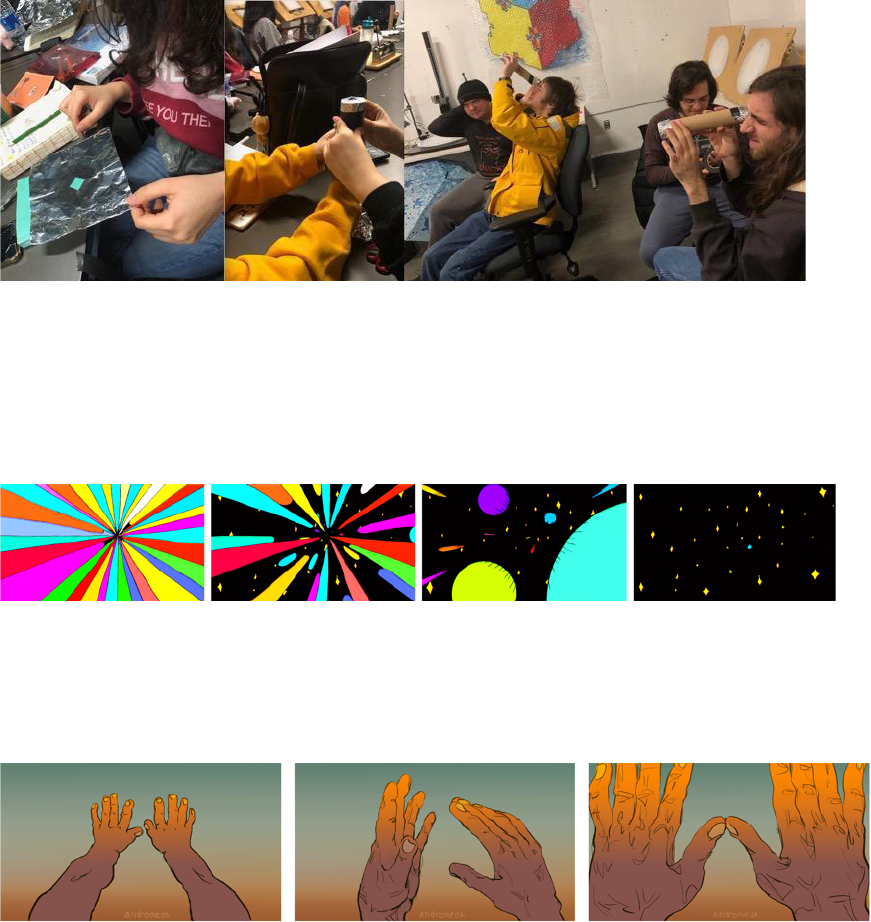
5
Figure 1: Science experiments and demonstrations: Studying light with spectroscopes constructed by the students.
During the first two weeks, students hone their animation skills on broad scientific
concepts such as gravity and the scale of the Universe. It pushes them to connect spontaneously
with their personal experiences to represent the “unrepresentable” aspects of the universe
(Figures 2 and 3).
Figure 2: Sneeze - Tenzin Lhamo
I interpreted the Big Bang to start as an unprompted moment that has forever changed the
universe. A concept much easier to grasp is a sneeze. A person sneezes which causes germs, to shoot out
of one’s mouth in any direction…
Figure 3: Andromeda - Terri Ogwulumba
When reading about the scale of the universe, and realizing the relationship between distance
and time, I found it fascinating that our sight of the Andromeda Galaxy is of something millions of years
in the past. (...) it is interesting to consider the idea of light as a messenger and the idea that an object
like my hand is stuck a little bit more in the past if I hold it far away from my eyes than if I hold it close.
In week three, the scientists come to the class to present their current research topics
such as black holes, supernovae, dark matter, and gravitational waves (Figure 4). Students are
randomly assigned a topic and a mentor scientist (Figure 5). They work in groups of two or
three to produce approximately six to eight projects in total. Communication between the
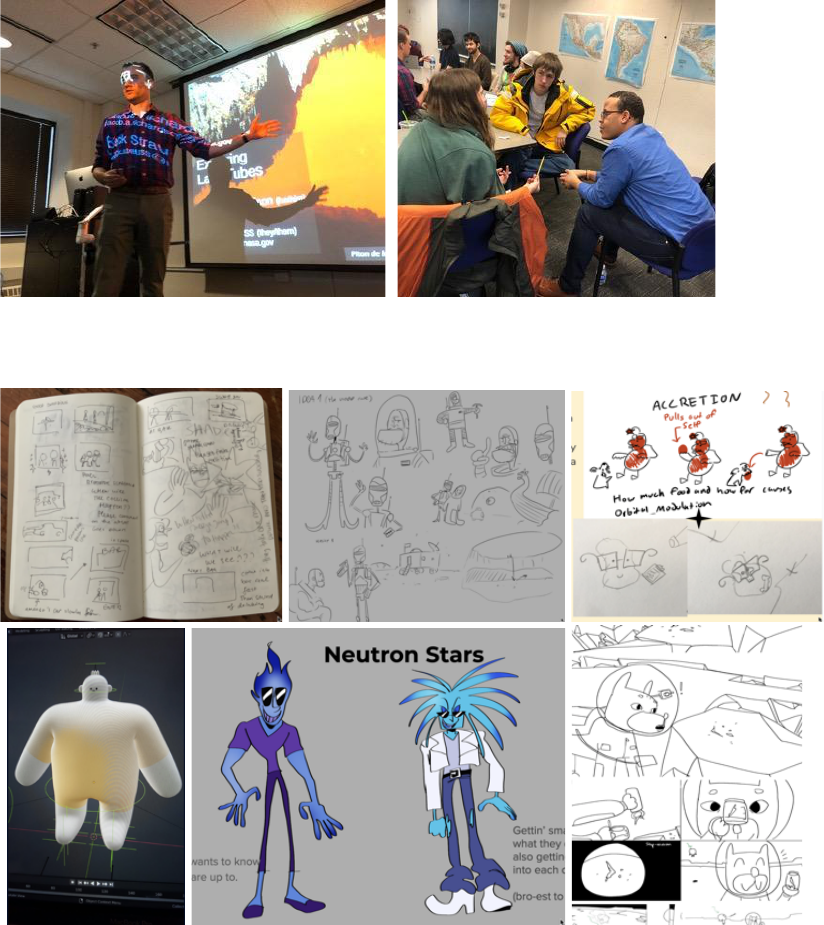
6
student teams and their mentors happens through email and social network sites such as Tumblr
(Figure 6).
Figure 4: Scientist presenting his research Figure 5: Students talking with a scientist
Figure 6: Examples of graphic research from various student projects.
In week five, students visit NASA GSFC (Figure 7a). After a tour of the campus, they
present their concept designs, storyboards and animatics (Figure 7b) to the scientists during a
lunch-time session (Figures 8a, b).
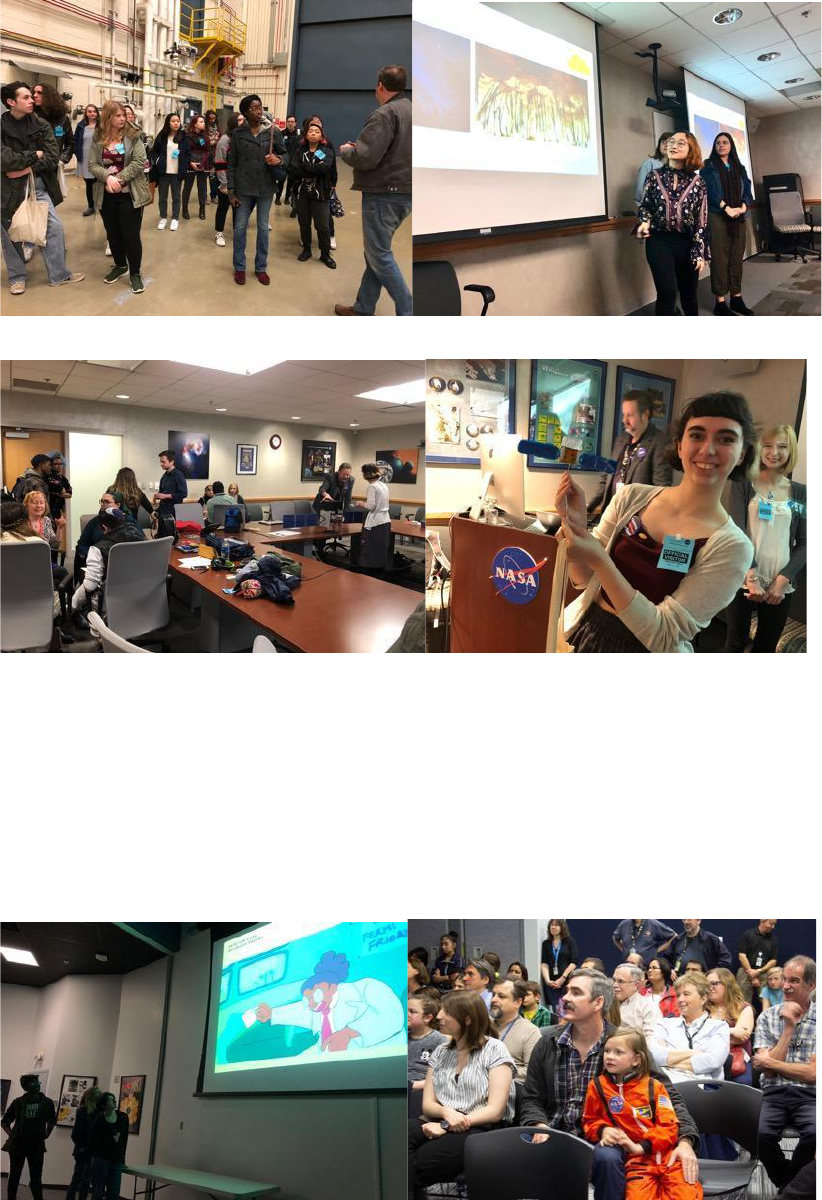
7
Figure 7a: Students touring NASA GSFC Figure 7b: Students presenting storyboards
Figure 8a: Post-presentation discussions Figure 8b: Student showing her Fermi satellite model
During weeks six to 13, students work on the production of their animations for a final
screening at the NASA GSFC Visitor Center. The screenings have occurred on “Take Our
Daughters and Sons to Work Day” (Figure 9b). The latest live screening in 2019 had a large
audience that included many employees with their children, which we have to keep in mind for
our presentation. Even if many of the animations the students produce are child friendly, they
are not specifically aimed at children and the target audience is the students’ decision.
Figure 9a: Students presenting their animation Figure 9b: Take Our Daughters to Work Day at NASA GSFC
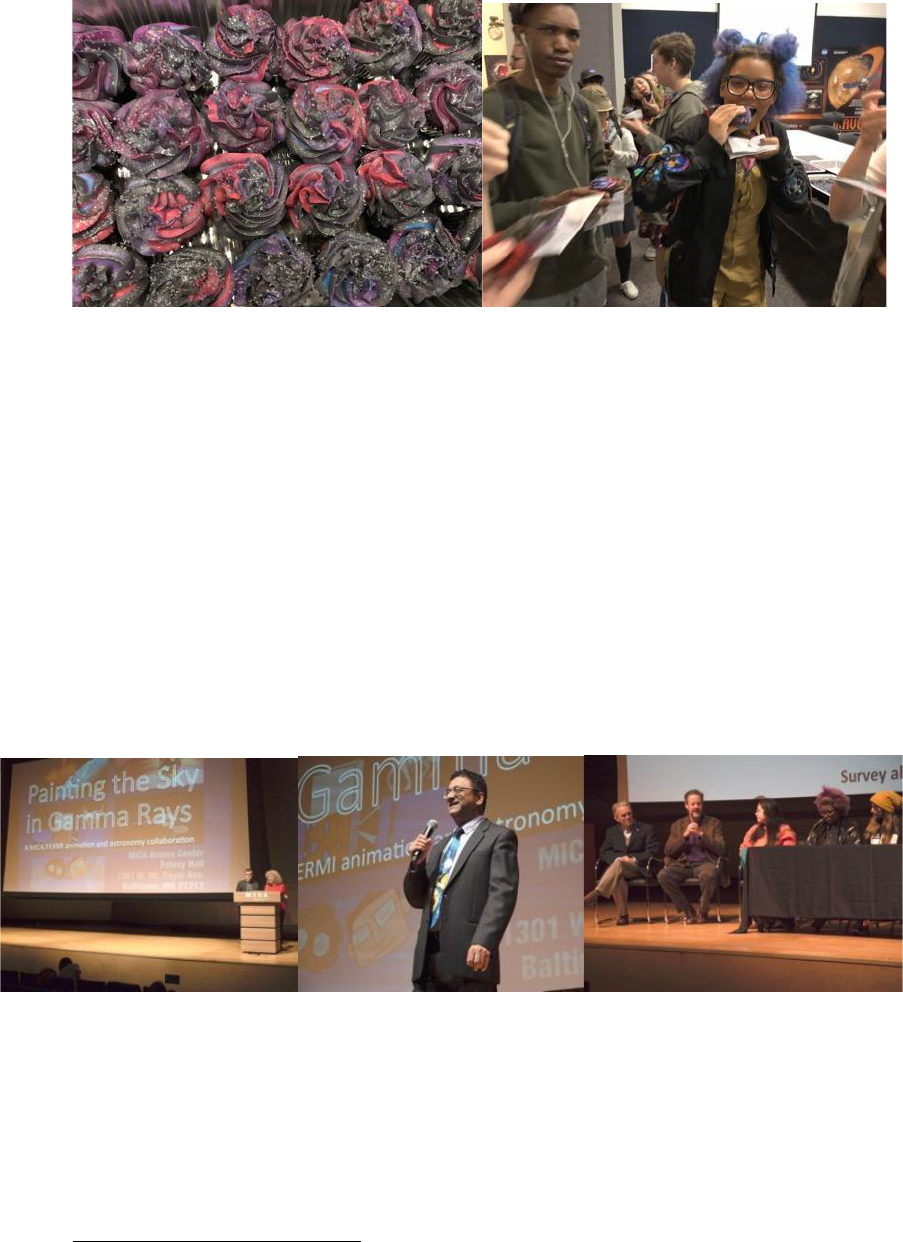
8
Figure 10: Galaxy cupcakes by the Fermi cake committee
Every year, the Fermi Cake Committee has generously rewarded the students with their
own space-inspired cake creations and is now part of the tradition (Figure 10). The Fermi
Gamma-ray Space Telescope team at GSFC have been valuable supporters from the very
beginning. After this screening, the animations are finalized for our website -
AstroAnimation.org. As of early 2021, there are forty-seven animations covering a range of
topics. Each film is typically about two minutes long and is freely available for download under
a licence that allows non-commercial use. The animations have been featured at a variety of
additional venues including science fiction conventions, art festivals, a STEAM
2
festival, public
outreach presentations, and have been used in college and university science classes. They have
been presented in a variety of formats, including “stand-alone” events hosted by scientists and
animators, or only scientists (Figures 11, 12).
Figure 11: “Painting the Sky with Gamma Rays” screening at MICA curated by scientists and animation students
during the 8th Fermi symposium- Oct 2018
2
STEAM: Science, Technology, Engineering, Art and Mathematics. A for Art was added later to STEM.
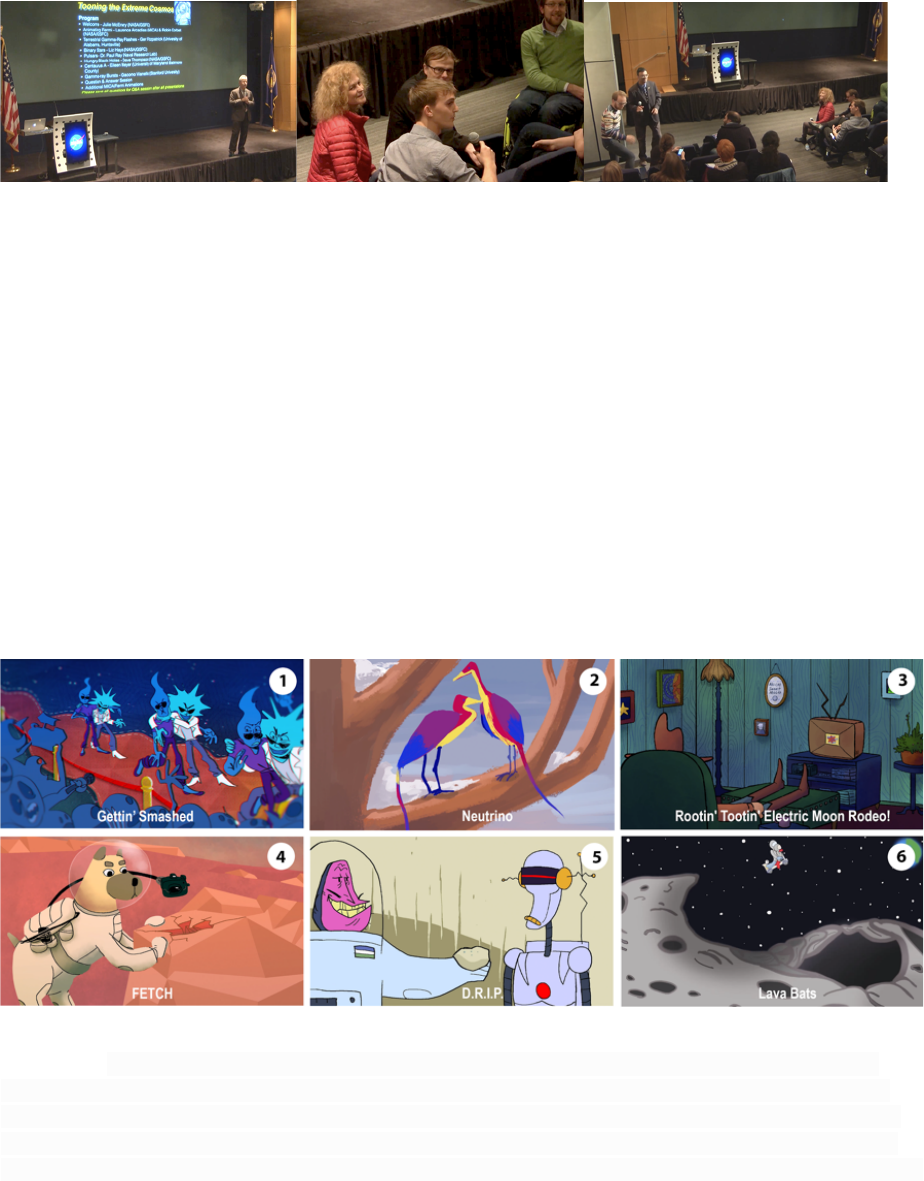
9
Figure 12: Paul Hertz Director of the Astrophysics Division presenting the “Tooning the extreme cosmos” screening
at NASA Headquarters in Washington DC and a MICA student answering questions - Fermi Symposium 2015
Artistic Implications
Metaphoric or poetic interpretations in the animations
Animation has the power to tell stories in a variety of styles and approaches that are unique to
this medium (Wells 1998). In Understanding Animation, Wells talks about narrative strategies
specific to animation. When the students explore a scientific concept and turn it into an
animation it is expressed in a totally different light from the raw science. It takes a new form
that can be playful, surprising, humorous or metaphoric and become more accessible to some
viewers (Figure 13).
Figure 13: Various metaphorical representations
#1- Paparazzi tail celebrated neutron stars during bar crawling. #2- A documentary inspired
approach depicting a neutrino, a gamma ray, and protons as birds taking a journey. #3- An astronaut
traveling in lunar craters as a cowboy trying to find electricity to power his Moon barn. #4- The Martian
sequel (on Titan) with a dog replacing Matt Damon. #5- A search for water on the Moon with a human
astronaut versus a robot. #6- Bat scientists investigating lunar lava tubes, inhabited by a mysterious cult.
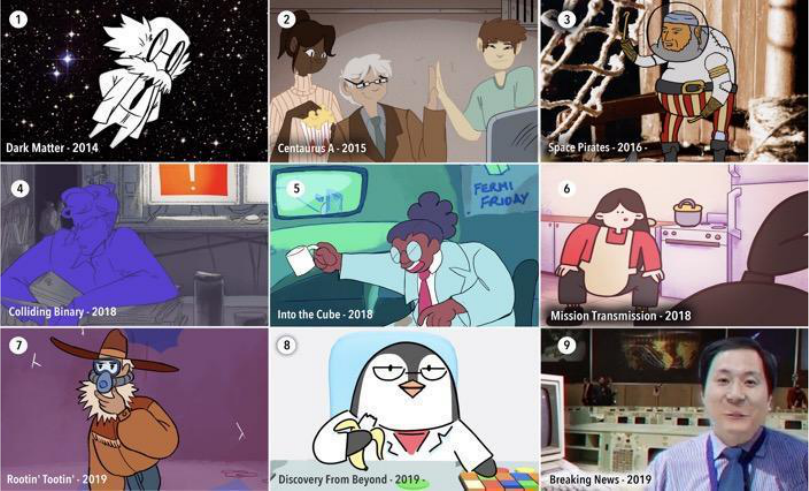
10
Character Representation
Over the seven years that the class has been taught, the animations from the students have
evolved. One early issue was to break clichés of scientists in character representation. By
bringing scientists into the classroom, students realized that a lot of scientists looked like them,
although typically older, from various ethnic origins, and even having similar personalities. This
change of perception has been reflected in recent animations through more playful
representations of scientists (Figure 14).
Figure 14: In these images from student films from 2014 to 2019, we see the evolution of the representation of
scientists.
# 1, scientist as an Einstein, white male figure. # 2, more inclusive ethnic, age and sex
representations but still in traditional roles with the older man in control. # 3, 7, 8, artistic licence with
scientists as a pirate, a cowboy, and an anthropomorphized animal. # 6 represents a mom scientist in
both her role of parent and scientist. # 4 and 5 portray scientists with borderline behaviours (sleeping at
work, low key). # 9 is an Asian-American scientist from the ‘80s/’90s. # 5 is an African American female
scientist. # 1,2,5,9, scientists shown wearing ties.
In addition to scientist figures, the animations often depict other characters including
children and their parents in family situations. We noted that to date no father characters have
been portrayed while mother figures are often represented, as well as non-traditional family
models such as a single mother or lesbian parents (Figure 15). We speculate that students no
longer feel the need to have a father or male figure for validation. The female figure, either as a
mother or a scientist, has the same authority and conveys identical trust. The racial diversity of
the students in the classroom is well represented through the multiple ethnicities of the
characters, including the scientists, showing a level of comfort from our students to identify
with these characters (Figure 14).
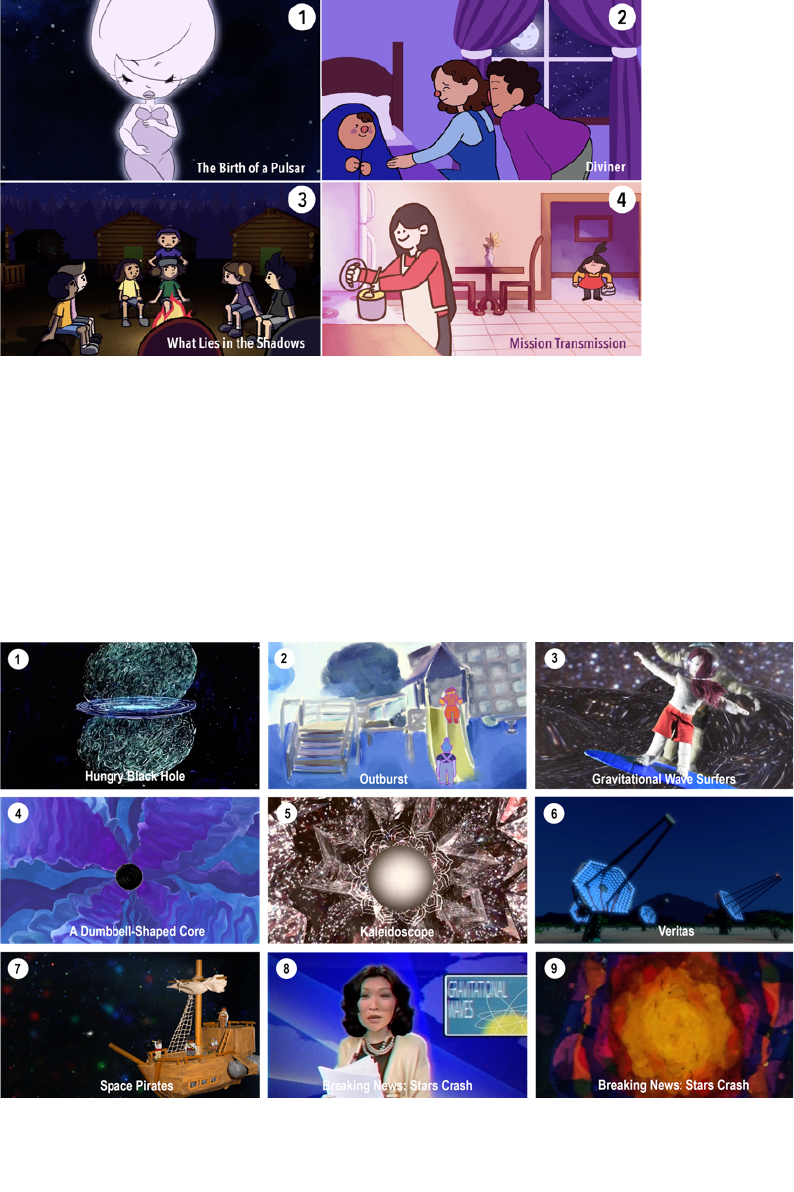
11
Figure 15: Various parental representations
# 1, A mother star pregnant with her baby neutron star. # 2, One family included a small child
and her two same-sex parents. # 3, One mother character in a group of children around a campfire. # 4,
One single mother with her daughter.
Techniques
One goal is to push students to be as experimental as possible using any technique they want,
from 2D to 3D to stop-motion and to explore their personal vision (Figure 16).
Figure 16: Various animation techniques used by students
# 1- Paint on glass. # 2- Watercolour. # 4- 3D+ stop-motion. # 4- Cut out paper.
# 5- 3D. # 6- 3D. # 7- 2D and stop-motion. # 8- Digital cut-out. # 9- Wax strata-cut.

12
Evaluation of the astro-animation project
We received a National Endowment for the Arts (NEA) grant to evaluate the benefits and
outcomes of the astro-animation project. We conducted surveys and interviews among a variety
of groups, including scientists, animation students, and non-specialist audiences. The overall
conclusion was that presenting astronomy via animation is highly attractive to a range of
audiences. We also found that simply screening the animations on their own has a visual
impact. However, for more specific science learning it is valuable to have some additional
scientific presentation.
Scientific accuracy and artistic licence
One question we investigated is how far we can go with the visual representation of the
scientific concepts and how to give as much creative freedom as possible to the students while
maintaining scientific accuracy. Most scientists have been very open to students' interpretations.
For example, a student represented the inside of a black hole as a donut world into which an
astronaut was swallowed (Figure 17). The scientist’s reaction was that since we don’t know the
answer, any interpretation is fine, underlining that science is as much about what we don’t know
as what we do know. This opens a door for artistic exploration, potentially engaging with
scientific dilemmas. But some scientists may not have the same level of comfort with the
students’ creative licence, as reflected in a comment from the survey that the science may get
lost, or miscommunicated. When the animations try to be educational, there is a greater chance
the students may misrepresent scientific facts, while inspirational pieces are more open to
interpretation. A complex science problem may be difficult to understand in a few minutes of
animation, but instead, the animation may help “engage with the science and suggest different
ways of seeing” (Ede 2005). It can also inspire the audience to look for more information.
Figure 17: Donut Hole- Puglisi, Whang, Wang ’15
Art and Science as Mutual Inspiration
We also explored whether this collaboration has led to any impact from art on the scientific
research being undertaken. Some authors, such as Root-Bernstein (1999), Miller (2001, 2014),
and Chomaz (2018) have considered potential influences by art on scientific research. For
example, Root-Bernstein (2000) states that many scientific techniques originate from art.
Anamorphosis, a Renaissance perspective technique, helped Thompson and Huxley describe

13
evolutionary and embryological processes as anamorphic distortions. As a side note, for an
animator it is exciting that astronomers discovered Pluto using a basic animation technique of
flipping between two photographs of the same sky area obtained at different times
3
. Lehrer
(2008) noted that “science needs art to frame the mystery, but art needs science so that not
everything is a mystery. Neither truth alone is our solution, for our reality exists in plural”.
Similarly, Shlain (1991) reported that “artists have mysteriously incorporated into their works,
features of a physical description of the world that science later discovers". He also addresses
the parallels between the works of Picasso and Einstein on time and space without any direct
interaction between the two, even though they both revolutionized art and science around the
same time.
Within the scope of our program, the answer to how art can challenge science is still
unclear at this level. In our surveys and interviews there is little evidence of the art students
affecting the actual research. However, the experience forced the scientists to clarify their
thoughts for better communication to students and consequently other non-specialists. In the
MICA students' interviews, even if this is certainly not a class requirement, a few felt and stated
that their animations had to be didactic: “There is a limit, you have to do something
educational”, “visual explanations are really the key to explaining things to the public”. These
comments made us aware that the students felt they needed permission to push animations in
the direction they wished. Perhaps an upper-level astro-animation class could have more
potential to stimulate art exploration, leading to some form of scientific discovery or deeper
art/science intersection.
Another critical component of the class is to expose art students to the scientific method.
It is important to know that science is a process, a way of questioning the world constantly, or
as philosopher Karl Popper put it, scientific knowledge "consists in the search for truth, but it is
not the search for certainty... All human knowledge is fallible and therefore uncertain” (Popper
1996). Working with scientists may give animation students a better understanding of the
scientific process and help them establish a method of their own. Scientific research and art
research share some similarities, emotion and intuition can even play an important role in
science. “All great achievements of science must start from intuitive knowledge… At times I
feel certain I am right while not knowing the reason” Einstein confided (Calaprice 2000). Being
exposed to these differences and similarities between science and art practice may inspire
students to further investigate the world through different approaches.
Student Internship Experiences at NASA
Each year, an astro-animation student has spent the summer at NASA GSFC for a paid
internship to work with scientists and outreach professionals. In addition, several students have
had the opportunity to undertake internships for credit. In summer 2020, two students worked as
3
PlutoBlink GIF: https://www.sightsize.com/wp-content/uploads/2015/08/PlutoBlink-Animated.gif
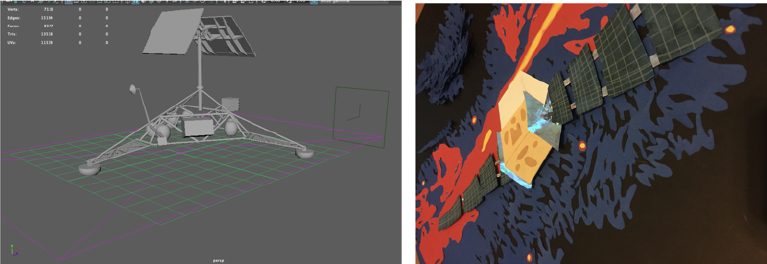
14
interns but, because of the COVID-19 pandemic, had to undertake this from home. Here are the
reports of their experiences.
Isabella Potenziani:
As an animator who works in stop-motion and 2D, I was intrigued to see where my style of
animation and astrophysics could lead to. With the mentorship of Corbet and Jay Friedlander, I
was able to learn more about the astrophysics division, as well as new animation skills. I
worked with many other NASA scientists, one of them, Roopesh Ojha, always took the time to
explain and go over information related to projects. Everybody was very patient with their
explanations providing me with resources that helped inform my projects.
Despite some challenges due to COVID-19, the overall experience was enriching and
engaging. I produced several projects I never imagined I would get the chance to create. Two of
the smaller projects I worked on during my internship were the making of a 2D GIF and a 3D
model in Maya. I had never done any intricate modelling, especially nothing based on a specific
object (Figure 18 #1). For the 3D model of Surveyor 1-7, I used only photos and a few technical
drawings. It was a different experience making something that accurately represented all the
parts of the craft. It was difficult at times considering many of the photos were taken from
similar angles.
Figure 18: #1-3D model of Surveyor 1-7 # 2- Fermi’s 12th anniversary
My largest project was the Fermi satellite’s 12th anniversary animation, using paper cut-
out puppets animated and overlaid onto a hand-cut paper background in post-production (Figure
18 #2). I really enjoyed working with several scientists in the division to create this piece. I also
was pleased to be making it in stop motion. It was challenging at times with the limitations I
had, but it did help me learn new techniques and ways of doing stop motion.
Declan McKenna:
My time as an Undergraduate Research Associate in Astrobiology focused on animation as a
method of and response to inquiry in astrobiology. Previous experiences with astronomical
topics prepared me for the program, such as my time assisting Arcadias, and the previous

15
creation of a film in the astro-animation course. At GSFC, I explored how to make animations
that are purposefully engaged with astrobiology.
Two questions were asked: what is the role of animation to the science of astrobiology,
and what is the impact of scientific research on the practice of animation?
I began with a series of interviews with animators, lab scientists, and media writers.
Guided by Andrea Jones, one of GSFC public engagement leads, I found that animation is most
useful in scientific contexts when it aids in understanding for an audience and displays the
scientific process and alternative perspectives on the research. As well, animations must be built
from trust and knowledge of the subject, and be appropriate for the way they are being
presented. The next phase of the research was emphasizing these qualities through direct
practice.
To facilitate an intentional approach to my animations
4
, I developed the Scientific
Method of Animation. Similar to the scientific method, this process incorporates five steps:
1. Ask a question that animation will answer.
2. Create an objective, such as the intended final output.
3. Experiment with the creative and research processes.
4. Draw conclusions from feedback.
5. Adjust, and arrive at a finished piece.
Figure 19: #1 Stills from two abstract gifs, created using oil pastels, depicting the glow of meteors as they enter
Earth’s atmosphere (left) and #2 the natural processes that occur inside of asteroids, such as water alteration (right).
This methodology was used for a NASA Web Feature on the Asuka 12236 Chondrite.
Under Lonnie Shekhtman, Senior Science Writer at Goddard, the question “What is the relation
of Asuka to the themes of life?” was posed, and the objective of two editorial gifs established.
After researching Chondrite studies in the analysis of early-Earth biological development,
several thumbnails and style tests were pitched. I made adjustments based on the feedback and
created two hand-drawn, abstract gifs interpreting Asuka, that were subsequently published
(Figure 19).
4
Usually, animation is not defined as a method, it’s up to the animator to choose or potentially create one.
We note that Nelson (2013) specifies a process which has some similarities to the one described here.
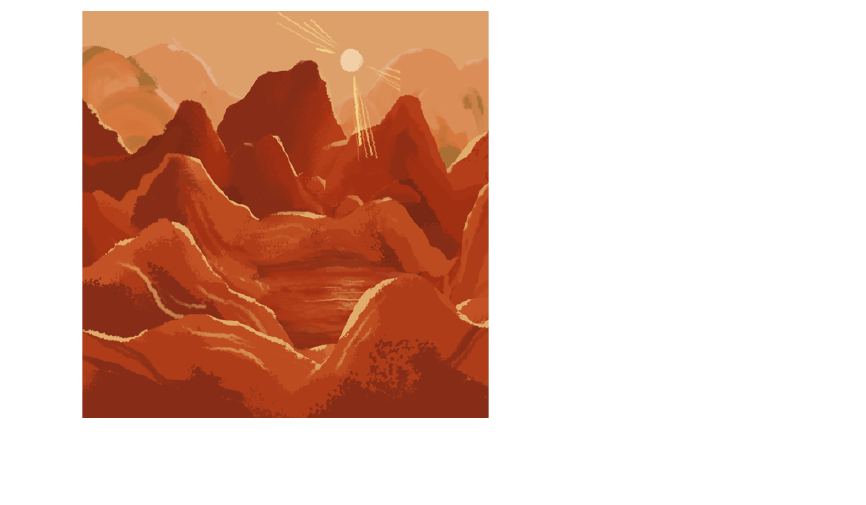
16
Operating remotely complicated my work - in-person meetings present opportunities to
draw, discuss, and restructure material alongside the scientists, and this process is difficult to
translate online. However, the discussions, and conferences I attended engaged me in the NASA
world and led to several incredible collaborations, such as an augmented reality depiction of
Ocean Worlds in our solar system (Figure 20). These projects showed that my animation
directly benefits from a methodical and intentional ideation process, like those governing the
scientific process, to increase accessibility. Compared to surface-level engagements, a work
environment similar to that of a scientific institution, one that focuses on immersion with
research, collaborators, and experimentation, leads to more introspective and informed
approaches to artistic creation.
Astronomical research and animation both investigate humans’ unique relationship to
the universe and to being alive. Integrations between art and science help ground and ignite
passion between researchers, artists, and the audience, connecting all parties together in the
exploration of the meaning of life.
Figure 20: Illustration of the surface of Titan, used for an
Augmented Reality Instagram filter.
Conclusion and Future Directions
Overall, we found the collaboration between animation students and NASA scientists to be
highly effective and well-received by most participants. The program was found to be a
successful way to engage art students with science. At the same time, a large number of
scientists have found it worthwhile to participate and have been excited to see their scientific
research converted into an animation. The contributions from the intern students are very
important for them to learn how they can find their place as artists working around scientists.
Potenziani managed to do a stop-motion piece for the Fermi gamma-ray space telescope’s 12th
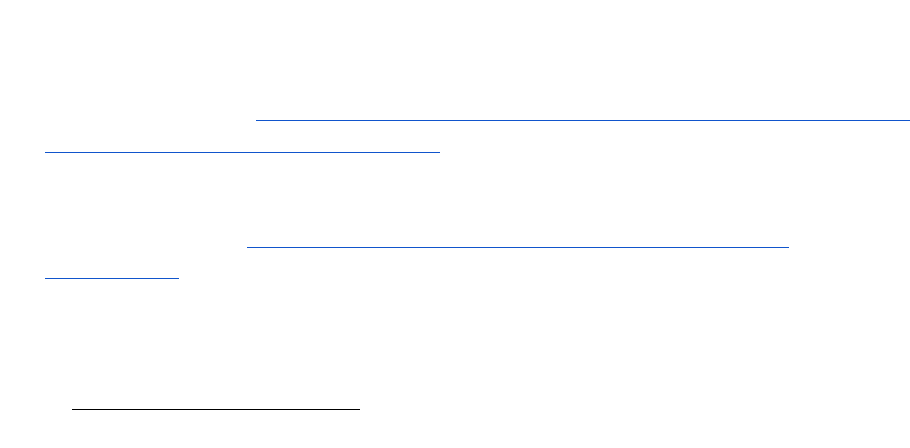
17
anniversary animation which was very successful and unexpected since graphic work at NASA
is usually digital. The made-by-hand cut-out technique added a human-touch warm feeling to
the birthday celebration of the satellite. McKenna worked in a different division and describes
his own animation process as a parallel to the scientific method that could be understood by his
team. That was an efficient way to highlight the importance of his role as animator when
investigating astrobiology for outreach.
In addition to continuing the program, we are exploring ways to develop it and take it
outside of the classroom. One promising new avenue would be to use astro-animation as a basis
for an informal learning program. In a “Guerrilla-STEM”
5
setup, we intend to design an
itinerant astro-animation exhibition with hands-on artistic and scientific activities, to be
displayed in unexpected locations such as libraries, train stations or music festivals. The goals
are to engage participants who are not a priori attracted to, or aware of science. Integrating
animation with astronomy, both of which have general popularity, may generate unique appeal,
curiosity and initiate easier learning. The long-term benefits of this project would include
increased interest in STE(A)M, expanded participation in science by underrepresented groups,
and enhanced interdisciplinary collaboration in science and art.
Acknowledgements
We thank many people at NASA and elsewhere who have contributed to this project, all the
students who have participated, and the paper referees for valuable comments. This work was
supported in part by the NEA (17-3800-7013) and NASA (80GSFC17M0002).
References
Arcadias, L. & Corbet, R. (2015), ‘Animating Fermi - A Collaboration Between Art Students
and Astronomers’, Leonardo, 48, no. 5.
Amidi, A. (2017), ‘3 Key Ways That Europe’s Feature Animation Scene Differs From The
U.S.’, Cartoon Brew. https://www.cartoonbrew.com/feature-film/3-ways-europes-feature-
animation-scene-differs-u-s-150081.html
Barak, M., Ashkar, T. and Dori, Y.J. (2011), ‘Learning science via animated movies: Its effect
on students’ thinking and motivation’. Computers & Education, 56(3), pp.839-846.
Botticello, Casey (2019), https://caseybotticello.medium.com/what-is-guerilla-art-
91c7dfbcbea5. Accessed 31 January 2021.
Braga, Brannon, Bill Pope, Ann Druyan, Livia Hanich, Steve Holtzman, Steven Soter, Alan
Silvestri, et al. (2014), Cosmos: a spacetime odyssey.
Calaprice, A. (2000), The Quotable Einstein, Princeton University Press; 2nd edition
5
Guerrilla STEM derives from Guerrilla Art: “A method of art making where the artist leaves
anonymous art pieces in public places” (Botticello 2019). Similarly, the Guerrilla Science group (Zivkovic
2011) employs “‘science by stealth’ … to stretch traditional boundaries of how people engage with
science”.

18
Chomaz, J.M. (2018), ‘It Is Time to Think the Anthropocene! A Manifesto,’
Leonardo, Volume 51, Issue 2, 217-219.
Dalacosta, K., Kamariotaki-Paparrigopoulou, M., Palyvos, J.A. and Spyrellis, N. (2009),
‘Multimedia application with animated cartoons for teaching science in elementary
education’. Computers & Education, 52(4), pp.741-748
Ede, S. (2005), Art & Science, London: I.B.Taurus
Fleischer, David (1923), The Einstein Theory of Relativity, USA: Fleischer
Studios.
Folman, Ari (2008), Waltz with Bashir, Israel: Bridgit Folman Film Gang.
Halas and Batchelor from <Hoffer, T. 1981, Animation: a Reference guide,
Westport Connecticut: Greenwood Press> in Wells, P., 1998
Understanding Animation London: Routledge, p11
Hubley, John and Faith (1961), Of Stars and Men, USA: Brandon Films.
Lehrer, J. (2008), Proust was a Neuroscientist, New York: Mariner Books.
Mann, Adam (2016), ‘Science and Culture: Looking at a shared sky, through the
lens of art’, Proceedings of the National Academy of Sciences, 113(50),
pp.14165-14167.
Merleau-Ponty, Maurice (1962), Phenomenology of perception. London: Routledge.
Masetti, M. (2014), ‘The Nexus of Art and Science, Part 2’, Blueshift.
https://asd.gsfc.nasa.gov/blueshift/index.php/2014/08/25/can-you-animate-the-sound-of-a-gamma-
ray-burst/ Accessed 31 January 2020.
Méliès, G. (1902), A Trip to the Moon. France: Blackhawk Films.
Miller, A. I. (2001), Einstein, Picasso: Space, Time, and the Beauty That
Causes Havoc. New York. Basic Books.
Miller, A. I. (2014), Colliding Worlds: How Cutting-Edge Science Is Redefining
Contemporary Art. New York. W.W. Norton & Company, Inc.
Nelson, R. (2013) Practice as Research in the Arts, Houndsmills: Palgrave
Macmillan.
Popper, Karl Raimund (1996), In Search of a Better World: Lectures and
Essays From Thirty Years. New York: Routledge.
Roe, A.H. (2013), Animated documentary. New York: Palgrave Macmillan.
Root-Bernstein, Robert and Michèle (1999), Sparks of Genius, New York:
Mariner Books.
Root-Bernstein, Robert (2000), ‘Art advances science’, Nature, Vol 407, 14
September.
Sagan, Carl, Ann Druyan, Steven Soter, Adrian Malone, Tom Weidlinger, Geoffrey Haines-
Stiles, David Kennard, et al. (1980), Cosmos: a personal voyage. Studio City, CA: Cosmos
Studios.
Sagan, Carl (1995), The Demon-Haunted World: Science as a Candle in the Dark, Ballantine
Books.

19
Shlain, Leonard (1991), Parallel Visions in Space, Time, and Light, New York:
William Morrow & Co.
Snyder, Timothy (2021), ‘The American Abyss’, The New York Times
Magazine, 9 January.
Strøm, Gunnar (2001), ‘The animated documentary, a performing tradition’, Norsk
medietidsskrift 02 /(Volum 8)
Tingay, S. (2015), ‘Indigenous culture and astrophysics: a path to reconciliation’, The
Conversation, July 6.
Venkatesan, A. & Burgasser, A. (2017), ‘Perspectives on the Indigenous Worldviews in
Informal Science Education Conference’, The Physics Teacher, 55, 456.
Wells, P. (1998), Understanding Animation, London: Routledge.
Wells, P. (2016), ‘Writing Animated Documentary: A Theory of Practice’. International
Journal of Film and Media Arts, 1(1).
